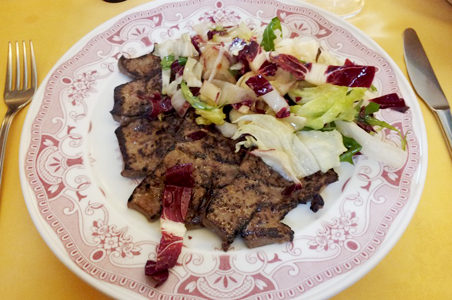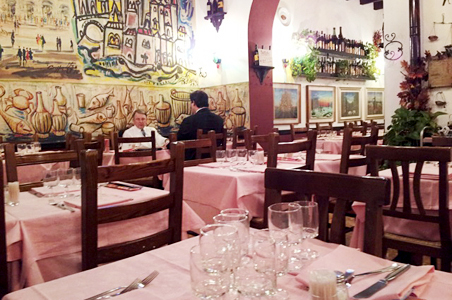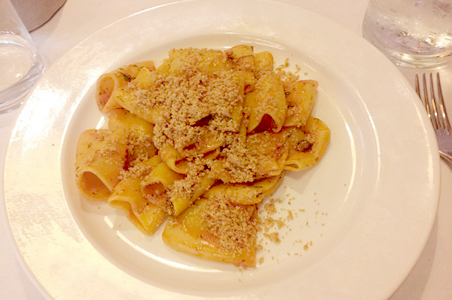As the financial capital of Italy, and the fashion capital of Europe, Milan is a fierce and unique alternative to the more well-worn Italian destinations. As a visitor, a great way to experience this culture—of crocodile stilettos, antique bicycles, strict social etiquette, and culinary theater—is to join the locals for lunch.
Needless to say, the notoriously high standards of your average Milanese don’t tolerate the tourist traps near il Duomo, or La Galleria Vittorio Emanuelle. Instead, take a ten minute walk, ride the metro one or two stops, or hop in a taxi for a short jaunt, and you’ll find the authentic heart of this truly fabulous city.
Who: The Laborer

In the middle of Milan’s very own Chinatown, Al Carpaccio is the perfect spot to eat like a working class Italian. Their daily prix fixe offers simple but superior plates like maccheroni all’ amatriciana, or fegato (veal liver) with radicchio. If eating both un primo and un secondo proves overwhelming for lunch, a moment’s rest should make room for homemade crème caramel and café. For insider treatment, arrive wearing any AC Milan football insignia: at Al Carpaccio, truck drivers sit with office workers, tattooed musicians, and the occasional Chinese vegetable vendor, but according to the owner, “Siamo tutti Milanisti qua!” (“We are all AC Milan fans here!”).
Recommended Fodor’s Video
Ristorante Al Carpaccio, Via Giovanni Battista Bertini, 14 14; no credit cards.
Who: Fashion Industry Folk
While Milan’s patrons peruse the luxury boutiques on Via della Spiga, the workhorses behind these fashion houses are usually found in Porta Genova, lunching on Via Tortona. Hidden away here—mere meters from active train tracks, Milan’s best example of “industrial chic”—lie design shops, showrooms, and plenty of lunch time oases. Osteria del Binari, with its leafy atrium and classic cotoletta (veal cutlet), is everyone’s favorite. A more recent addition, Les Gitanes Bistro, with its retro Parisian vibe, offers tamer plates like roast beef with artichokes and an Italian approach to the club sandwich. Lunch is fast in this industry, though always done with style.
Who: The Local VIP
When proposed to locals, Malastrana Rossa can polarize. While most agree its pizza is delicious, for some it is too scene-y, filled with glamour girls, soccer players, reality stars, and lots of Roberto Cavalli Jeans. At lunch, tables are topped with red meat: either bloody and on the bone (called la costata), pounded and raw with rucola (carpaccio), or tender and classic (the filetto pepe verde). The walls are hung with splashy paintings, enlarged Ralph Lauren Polo campaigns, and Polaroids of the owner with every bombshell to have dined with him since its opening. For less meat and scene, but a truly exceptional pizza, try Sibilla down the street.
Malestrana Rossa, Via Palermo, 21
Pizzeria Sibilla, Via Mercato, 14
Who: The Businessman

While famous spots like Giannino or Trussardi are known for their nouvelle platings and hordes of paparazzi, Al Matarel is known for discretion and a sumptuous adherence to medieval Milanese cuisine. Here, lunch is not fast and international, but rather long and Italian, often including plump porcini with vinegar, house made tortellini di stracotta, the original Oss Büss with risotto: the rice is toasted and tied with a ribbon of marrow, and served with a silver spoon balanced in its bone. Piedmontese wines match well, and diners that linger often finish with digestivos.
Al Matarel, Corso Garibaldi 75
Who: The Graphic Designer

With high white walls, soft yellow lanterns, and beautifully bright wood work on the ceiling, Pasta Madre is a breath of aesthetic air. The restaurant revolves around the daily labor done by its in-house pasticciere and pastaio: those responsible for the sweets and fresh pasta. Their evolving menu offers fresh revivals of forgotten recipes, as well as precisely tempered experiments. Plates—such as fresh pasta with spring-onion pesto, wild fennel, and prawns—tend to be delicate in flavor. For a punch of Italian indulgence, finish with their monte bianco, a heavenly castle of chestnut cream, meringue, and marron glacé.
Photo credits: Al Carpaccio, Pasta Madre, and Al Matarel courtesy of Sarah Lewis; Osteria del Binari courtesy of Osteria del Binari


